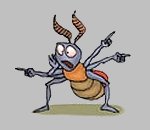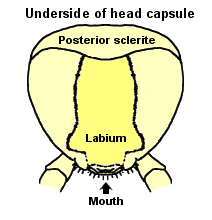Hexapods
Judging from the fossil record, hexapods must have diverged from crustacean stock during the late Ordovician or early Silurian periods (400-500 million years ago). At this time in geological history, land masses were dotted with shallow inland seas, and plant life (mostly algae and bryophytes) was largely restricted to coastal habitats and other sites where water was readily available. The oldest hexapod fossils are found in rocks of the late Devonian period. These rocks also contain numerous other terrestrial arthropods (mites, spiders, centipedes, scorpions, etc.) suggesting that a major radiation of terrestrial life-forms must have occurred during the Ordovician or Silurian period.
 At one time, all six-legged arthropods were considered “insects”. It was a simple and elegant arrangement — you just counted legs! But as we continue to learn more about these fascinating creatures, it has become increasingly difficult to justify grouping all “six-leggers” in a single class. There are major differences in external structures, organ systems, and post-embryonic development that seemingly point to evolutionary divergence between the “true” insects and three other closely allied groups: Protura, Diplura, and Collembola. Many entomologists still consider these three taxa to be “primitive” orders of insects, others prefer to classify them as orders in a separate class (the Entognatha), and still others insist that differences outnumber similarities and regard each taxon as a separate class of arthropods. This is the perennial debate between “splitters” and “lumpers”. The controversy is not new and it will not be settled quickly. In this course, we have chosen to recognize Protura, Diplura, Collembola, and Insecta as four separate classes of hexapods, but we will accord the non-insect classes equal emphasis and parallel treatment to each of the orders within the class Insecta. Obviously, we want to have our cake, and eat it too!
At one time, all six-legged arthropods were considered “insects”. It was a simple and elegant arrangement — you just counted legs! But as we continue to learn more about these fascinating creatures, it has become increasingly difficult to justify grouping all “six-leggers” in a single class. There are major differences in external structures, organ systems, and post-embryonic development that seemingly point to evolutionary divergence between the “true” insects and three other closely allied groups: Protura, Diplura, and Collembola. Many entomologists still consider these three taxa to be “primitive” orders of insects, others prefer to classify them as orders in a separate class (the Entognatha), and still others insist that differences outnumber similarities and regard each taxon as a separate class of arthropods. This is the perennial debate between “splitters” and “lumpers”. The controversy is not new and it will not be settled quickly. In this course, we have chosen to recognize Protura, Diplura, Collembola, and Insecta as four separate classes of hexapods, but we will accord the non-insect classes equal emphasis and parallel treatment to each of the orders within the class Insecta. Obviously, we want to have our cake, and eat it too!
 Structurally and ecologically, the non-insect hexapods are rather similar to one another. All members of these taxa exhibit ametabolous development (egg, young, adult); the proturans gain one abdominal segment during each of the first three molts (anamorphosis). The Protura, Diplura, and Collembola are restricted to moist environments because their exoskeletons lack a protective layer of wax that seals, waterproofs, and minimizes desiccation. Their thin body wall also permits gas exchange with the environment and serves as an important respiratory organ (some protura lack a tracheal system). During a molt, the exoskeleton of Protura and Collembola splits transversely behind the head (like millipedes and centipedes), rather than longitudinally along the back (as in other insects).
Structurally and ecologically, the non-insect hexapods are rather similar to one another. All members of these taxa exhibit ametabolous development (egg, young, adult); the proturans gain one abdominal segment during each of the first three molts (anamorphosis). The Protura, Diplura, and Collembola are restricted to moist environments because their exoskeletons lack a protective layer of wax that seals, waterproofs, and minimizes desiccation. Their thin body wall also permits gas exchange with the environment and serves as an important respiratory organ (some protura lack a tracheal system). During a molt, the exoskeleton of Protura and Collembola splits transversely behind the head (like millipedes and centipedes), rather than longitudinally along the back (as in other insects).
 Protura have no antennae, but Diplura and Collembola have well-developed, multisegmented antennae. The entire length of the antenna is musculated — every segment is equipped with individual muscles, and every segment is independently capable of movement. Most evolutionary biologists regard this as a “primitive” state (pleisiomorphic condition) because all other six-legged arthropods (the true Insecta) have muscles in only the scape and pedicel, the two basal segments of the antennae.
Protura have no antennae, but Diplura and Collembola have well-developed, multisegmented antennae. The entire length of the antenna is musculated — every segment is equipped with individual muscles, and every segment is independently capable of movement. Most evolutionary biologists regard this as a “primitive” state (pleisiomorphic condition) because all other six-legged arthropods (the true Insecta) have muscles in only the scape and pedicel, the two basal segments of the antennae.
 External fertilization is another pleisiomorphic character found in the non-insect hexapods. All of these animals have separate sexes (dioecious) but direct insemination of the female (copulation) does not occur. Instead, the male produces packets of sperm (spermatophores) that he sets on the ground or other substrate to be picked up by passing females. In general, spermatophores are deposited randomly in the environment and left for chance discovery by a receptive female. In some species, the males deposit spermatophores only in the vicinity of a prospective mate.
External fertilization is another pleisiomorphic character found in the non-insect hexapods. All of these animals have separate sexes (dioecious) but direct insemination of the female (copulation) does not occur. Instead, the male produces packets of sperm (spermatophores) that he sets on the ground or other substrate to be picked up by passing females. In general, spermatophores are deposited randomly in the environment and left for chance discovery by a receptive female. In some species, the males deposit spermatophores only in the vicinity of a prospective mate.
 The most distinguishing characteristic of Protura, Diplura, and Collembola, and another feature that sets them apart from other insects, is the way their mouthparts are enclosed within the head capsule. This condition probably evolved through fusion of the labium and lateral head sclerites (hardened plates of the exoskeleton) along the lower portion of the head capsule. The mouthparts, therefore, are enclosed in a cavity that opens anteriorly. Food may be drawn into this cavity by suction and then chopped or ground by action of the mandibles and maxillae. Mouthparts enclosed within such a cavity are said to be entognathous, a term that is derived from the Greek “ento-” meaning inner and “gnathos” meaning jaw. All of the “true” insects are ectognathous: their mouthparts extend outside the head capsule.
The most distinguishing characteristic of Protura, Diplura, and Collembola, and another feature that sets them apart from other insects, is the way their mouthparts are enclosed within the head capsule. This condition probably evolved through fusion of the labium and lateral head sclerites (hardened plates of the exoskeleton) along the lower portion of the head capsule. The mouthparts, therefore, are enclosed in a cavity that opens anteriorly. Food may be drawn into this cavity by suction and then chopped or ground by action of the mandibles and maxillae. Mouthparts enclosed within such a cavity are said to be entognathous, a term that is derived from the Greek “ento-” meaning inner and “gnathos” meaning jaw. All of the “true” insects are ectognathous: their mouthparts extend outside the head capsule.
Protura
 Protura, the most primitive hexapods, are tiny (0.5 – 2.0 mm) secretive inhabitants of humus and leaf mold in temperate deciduous forests. Both adults and immatures feed on organic matter released by decay.
Protura, the most primitive hexapods, are tiny (0.5 – 2.0 mm) secretive inhabitants of humus and leaf mold in temperate deciduous forests. Both adults and immatures feed on organic matter released by decay.
Newly hatched proturans have nine abdominal segments. More about Protura Each time they molt, another segment is added near the end of the abdomen until they are fully grown (and sexually mature) with 12 abdominal segments. Additional molts may occur during adulthood, but the body does not grow any longer. Protura have no eyes or antennae. The front legs are usually held in front of the body and appear to serve a sensory function.
Diplura
 Diplura are also tiny, secretive animals that live in moist soil, leaf litter, or humus. They have small, eversible vesicles on the ventral side of most abdominal segments that seem to help regulate the body’s water balance, perhaps by absorbing environmental moisture. Most Diplura appear to be predators.
Diplura are also tiny, secretive animals that live in moist soil, leaf litter, or humus. They have small, eversible vesicles on the ventral side of most abdominal segments that seem to help regulate the body’s water balance, perhaps by absorbing environmental moisture. Most Diplura appear to be predators.
Their diet usually includes a variety of other soil-dwellers, including collembolans, mites, symphylans, insect larvae, and even other diplurans. More about Diplura They may also survive on vegetable debris and fungal mycelia, but most species seem to prefer animal prey. The Diplura have a pair of antennae, but no eyes. They also have a pair of cerci at the end of the abdomen. In the family Japygidae, these cerci are modified into strong pincers.
Collembola
 Collembola (springtails) are among the most abundant of all soil-dwelling arthropods. They live in a variety of habitats where they feed as scavengers on decaying vegetation and soil fungi. Most species are small (less than 6 mm in length) and quite susceptible to desiccation unless they remain in a moist environment. A unique, tube-like structure, the collophore, is located ventrally on the first abdominal segment of most species. This organ appears to regulate the animal’s osmotic pressure (water balance) by absorbing moisture from the environment.
Collembola (springtails) are among the most abundant of all soil-dwelling arthropods. They live in a variety of habitats where they feed as scavengers on decaying vegetation and soil fungi. Most species are small (less than 6 mm in length) and quite susceptible to desiccation unless they remain in a moist environment. A unique, tube-like structure, the collophore, is located ventrally on the first abdominal segment of most species. This organ appears to regulate the animal’s osmotic pressure (water balance) by absorbing moisture from the environment.
Springtails are named for the forked jumping organ (the furcula) found on their fourth abdominal segment. The furcula is retracted against the ventral wall of the abdomen and held there, in cocked position, by a special catch (the tenaculum) on the third abdominal segment. Releasing the tenaculum causes the furcula to snap down against the substrate and flip the organism some distance through the air. This device, present in all but a few genera, seems to be an effective adaptation for avoiding predation.
Immature Collembola are similar in appearance to adults. More about Collembola They usually molt 4-5 times before reaching sexual maturity, and continue to molt periodically throughout the rest of their life. Development is most rapid under cool, humid conditions.

